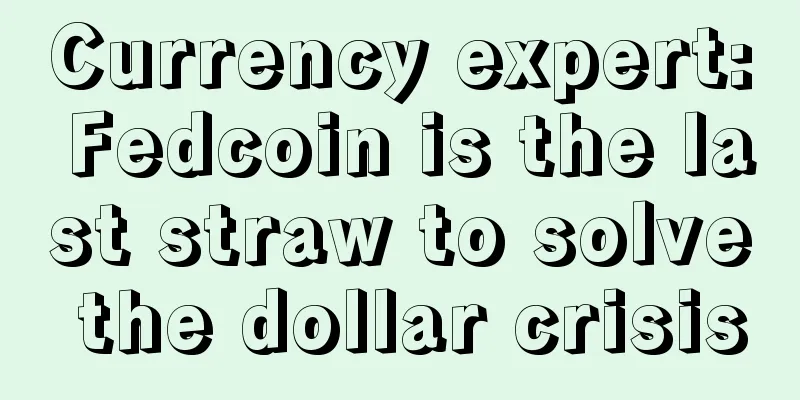Currency expert: Fedcoin is the last straw to solve the dollar crisis

|
The Federal Reserve will not only issue its own cryptocurrency, but will also ensure its domestic adoption. This is the prediction made by currency expert Doug Casey. Over the years, his predictions about economic and political situations have been eerily accurate. In his recently published book, Living in the Fedcoin Era: How to Protect Yourself from America's Coming Monetary Reform, he stated that the US government will definitely issue its own Bitcoin. Casey believes that this policy is the "last arrow" in the US currency "quiver" (the only way to solve currency crises). So how will the government do this? He speculated:
Fedcoin In “A Personal Insight into Fedcoin – A Federal Reserve-Backed Cryptocurrency” (March 9, 2015), Albert Szmigielski wrote:
In “Fedcoin” (October 19, 2014), JP Koning said:
Koning used some math and cited insights from economist Sina Motamedi to give “a more technical explanation” of how the Fed’s blockchain ledger would work. Motamedi said:
When the Bank of England published a report (full text download) to study the issue of national digital currency (February 2015), the discussion on this topic became more and more heated. I believe that Bitcoin payment company Payment21 is not the only one in the circle who is trying to find the answer: "Bank of England: Why does the central bank want to issue digital currency?" There are many similar activities in the United States. In June 2016, central banks from more than 90 countries held a closed-door meeting with Bitcoin experts in Washington. Janet Yellen, chairman of the Federal Reserve, presided over the meeting, and many well-known institutions including the International Monetary Fund (IMF), the World Bank (World Bank) and the Bank for International Settlements (BIS) participated in the gathering. Using blockchain protocols for bank transfers was the focus of the conference, but the topic of issuing official digital currencies also attracted a lot of attention. Adam Ludwin, CEO of blockchain company Chain, gave a speech titled "Why Central Banks Issue Digital Currencies". In his speech, he encouraged governments to adopt this disruptive technology to create new assets.
The key to issuing Fedcoin lies in the trade-offs that come with pegging cryptocurrencies to traditional currencies. This process of pegging may not be spontaneous. Motamedi explained:
Koning was more direct:
Why Fedcoin?Casey inferred support for Fedcoin in the Western world while analyzing the current state of the U.S. central bank system. He didn’t believe anything the Fed said. The U.S. government was already bankrupt because of its high debt, with total liabilities far exceeding total assets. Casey explained:
The dollar no longer has the stability of being the world's currency, a privilege that has long been threatened by countries such as China and Russia, which are actively exploring alternative mediums of exchange in global trade. As global currency correlations weaken, Casey believes that traditional monetary management methods - quantitative easing and zero or negative interest rates - can no longer support the increasingly weakened dollar. The traditional model "has reached the end of the road... So what should the Fed do?" The Fed can only issue a cryptocurrency; Fedcoin is coming soon. And, according to Casey, the main advantage of this policy by the government is that it centralizes supply and ensures transparency of demand (or transactions), thereby achieving the greatest degree of centralized control of the economy. So why should people use cryptocurrency? Fedcoin exists as a parallel currency that can be used to pay taxes or be associated with people's rights such as social security systems. In addition, Fedcoin can promote the development of a cashless society, because the privacy of physical currency is not conducive to centralized management by the government. Casey noted:
Fedcoin could give governments god-like powers to combat crimes like drug trafficking and money laundering, as they claim. However, there are holes in this argument; for example, most black market activities are ethical and not criminal. Casey also believes that Fedcoin could endanger the property and freedom of ordinary people.
Fedcoin can also become a powerful tool for social control. From the perspective of privacy, Fedcoin is the anti-cash.
Overweight people might not be able to buy candy; gun owners might not be able to buy bullets; teenagers might not be able to buy beer, cigarettes, or video games. The possibilities are endless. Fedcoin could even affect existing policies: Holders of food stamps (which the government gives or sells to low-income people at a low price to maintain a minimum standard of living) can't buy alcohol, go to casinos, or go to strip clubs. Fedcoin can bring great efficiency, but it can also exacerbate social divisions. The government can "ban everything without even passing a law... If your Fedcoin phone or chip limits your purchasing power, will you do whatever it takes to get what you want?" Politically controversial topics like gun registration may not be affected. I have my doubts about one of Casey's views. He believes that most Americans will accept the "chip implantation" control method of Fedcoin. But I never doubt the determination of ordinary people to defend their own interests. Technological progress?Casey likens this potential monetary reform to the Industrial Revolution. Advances in technology have given people unprecedented freedom and real life; life expectancy and population growth have also increased dramatically. Bitcoin and blockchain can also liberate individuals, but revolutionary technologies also challenge the status quo of society. Therefore, traditional forces will try to control these technologies. It’s unclear whether governments will succeed; perhaps they will fail due to their own incompetence or the centralized nature of cryptocurrencies. But it’s clear that governments are trying to control this technology. If they do, we should respond by pushing for technological progress and leaving those who refuse to follow through to history. Those working on cutting-edge technology are today’s freedom fighters. |
<<: Looking at the challenges of blockchain from the development history of the Internet of Things
>>: Talking about blockchain (10): Events and Logs in Ethereum
Recommend
Knowing people by their faces - what kind of people are popular
Appearance reflects the heart. Whether a person i...
Is it good for a man to have a narrow forehead?
In physiognomy, there are many important parts on...
What kind of plants are good to put in the bathroom for men with inverted eyebrows?
Many people are very concerned about the placemen...
Is it good for a woman to have dimples? Is she blessed?
As one of the traditional physiognomy techniques, ...
Tesla's US official website supports Bitcoin payments
According to BlockBeats, on March 24, Tesla’s off...
What is the saying about eyebrows?
Since eyes are the windows to our soul, we can th...
What are the signs of men with bad luck? These people have a hard life.
A person's life is destined when he is born. ...
Which celebrities have hanging needle lines on their foreheads?
Which celebrities have hanging needle lines on th...
Palmistry: Why is your career not going well?
Palmistry: Why is your career not going well? Eve...
Blockchain is in hot demand, Bitcoin trading platform Huobi.com makes a splash in Jiangsu
After the trips to Shanghai, Hunan, Hubei, Anhui,...
Can people with scars on the bridge of the nose become rich and powerful?
People with scars on the root of the nose have ba...
What does it mean when a woman has a mole on her chest?
For women, moles are something that people either...
South Korea’s Supreme Court to Judge Whether Local Crypto Regulation Is Unconstitutional
Rage Comment : A South Korean law firm filed a co...
These people always wear the wrong clothes
Clothes make the man, and a nice piece of clothin...
These 4 facial features often cheat. Who is most likely to cheat?
Nowadays, many people like to try new things, and...









